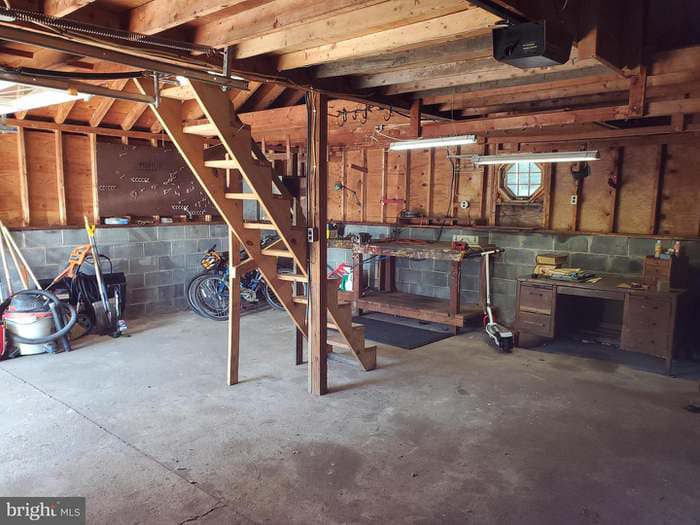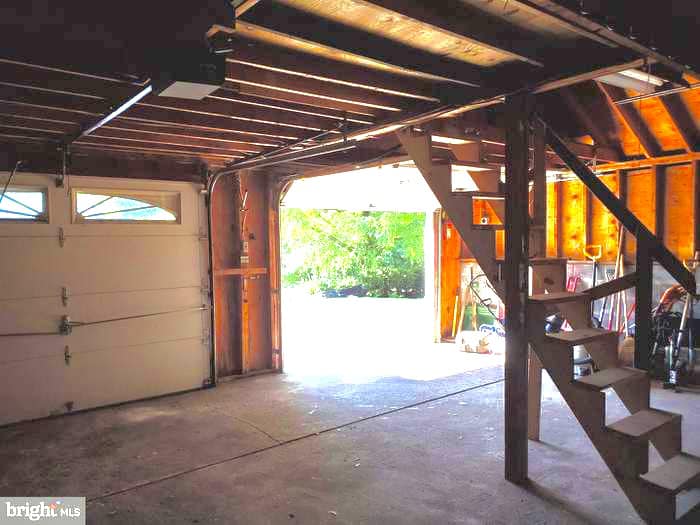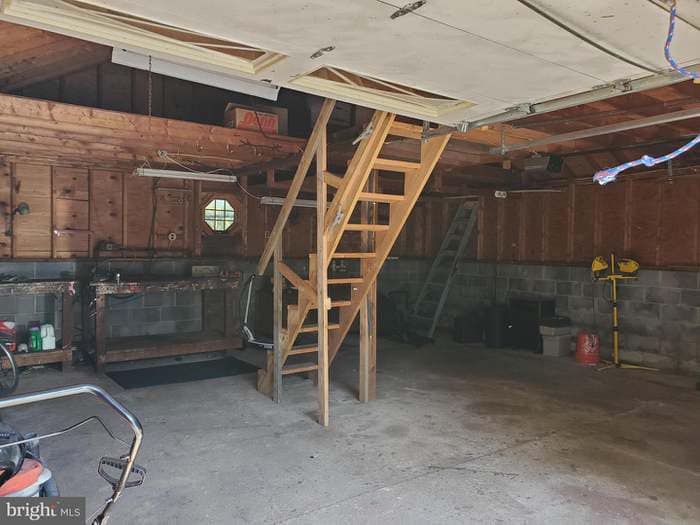Can I safely remove a staircase and post in my garage loft to create more space without compromising the existing beam’s support?
1 year ago
Last Updated: May 16, 2024
Hey there, just joined the group! I could use some advice. I’ve got a detached 2-car garage and I’m looking to get rid of this staircase and a 4×4 post that’s acting as a lally column. I want to open up the floor plan for my vehicle restoration projects. The stairs don’t really provide any structural support the way they’re set up. Any ideas on how I can support the beam well enough to remove the post without having to redo the whole loft floor?



Install temporary support walls on either side of the beam. Remove the lolly column and beam, and replace them with a single continuous engineered beam that is supported on both ends.
This is definitely the most practical choice.
The simplest explanation I can offer is having a larger beam placed next to the existing one, securely fastened with carriage bolts or a similar method to support it and create an open garage space. Additionally, relocating the stairs to an exterior wall would free up space and allow for easy access upstairs. Ideally, positioning them in the center would ensure proper headroom.
Only a structural engineer would be able to provide a proper response to that inquiry.
You will require a piece of structural steel for that.
Stairs are typically not intended for supporting heavy loads. One option is to install an engineered beam in place of the existing girder, or reinforce the girder by attaching two engineered beams together. Another solution is to place a steel I beam underneath the girder and support it on both ends.
Consider installing car lifts. Bolting them to your ceiling will enhance the structural integrity of your building.
That post isn’t a lally column, it’s just a regular post. Lally columns consist of metal poles filled with concrete. From the picture, it’s hard to determine, but it seems like the post was installed at a later time. I can’t say for sure. Was the beam spliced over the post? Was the loft and stairs added afterwards? If so, the beams may have been supporting the load without the post. It might be a good idea to have an engineer take a quick look at it.
I think the 4x doesn’t provide any structural support to the truss roof since there are no other 4x’s in the run. If you want to be certain, consult with an engineer, they will advise you on what needs to be done. It might cost around 100 bucks if I’m right.
Could we please take another picture up there from the angle of the bicycles?
Cables and turnbuckles… in theory at least! 😊 But it would need to be designed properly, considering cable size and brackets for both ends. You could possibly turn some walls on the second level into trusses, even if they’re just half walls, depending on your plans for that area. If you’re no longer using the attic, it’s an easy decision. However, if you’re relocating the stairs, as you mentioned you’re not…
Tie a long chain from your vehicle to the 4×4, then pull it from outside of the garage to see what happens. You probably don’t need an engineer right now; a knowledgeable licensed contractor should be able to figure out the next steps and provide free estimates for moving or removing a staircase.
That particular post bears a load. The only way to remove it is by swapping the beam with one that can span the entire length, most likely a steel beam. To replace the beam, you’ll have to support the joists on both sides of the beam and then proceed with the replacement. This isn’t a task that DIYers should tackle, as it can be dangerous if not done correctly. You’ll also need an engineer to design the beam for you.
What is the upper area utilized for? Is the beam continuous or is it connected above that column?
It’s basically just storage. The beam runs continuously. They attached 2x4s for some reason underneath the beam, but they don’t actually provide any structural support.
Did you mention what kind of beam it is? The material, dimensions, and span length of the current continuous beam are crucial in deciding whether a large new beam is necessary or if we can just remove the post and call it a day.
I’m inclined to believe they installed this beam to reinforce the rafter ties due to the added weight of storage. It appears that the beam is situated underneath them in the picture, but it’s not entirely clear.
There are plenty of lumber yards where you can order beams from. Many of them collaborate with beam companies to assist in designing the right size beam for your specific load requirements. I suggest starting there. Replacing the beam isn’t overly difficult, but it depends on the size of the beam you need to install. You’ll need to add studs to the walls under the beam and may need to reinforce the concrete where the studs supporting the beams are located.
Definitely consider hiring an engineer for an assessment. I believe those 4×4’s are mainly for stabilizing the stringers on the steps and providing a spot to attach a handrail. It’s worth the investment to hire a professional for peace of mind. In the future, you can add a pull-down stair for accessing storage above. Best of luck with your project.
Beam designed by an engineer. It may be expensive but effective.
Have a chat with a Civil or Structural Engineer.
My dad is a civil engineer, he mainly focuses on designing roads rather than ceilings, unlike who specializes in structural engineering.
I’m in the same boat as Kevin s. With the right knowledge and experience, we can also design buildings. But that’s not my area of expertise! 😄
That seems like a large span for a relatively small beam. It’s best to consult an engineer before removing any support posts. Calculations are important, especially for complex projects. You can use an engineer calculator like the one found at https://cecobois.com/ for guidance. Remember, safety first!
If you’re feeling creative, consider installing a beam below the joists to save space, but be aware that this may reduce headroom. Another option is to frame a 2×4 wall above with plywood on both sides to create a support beam. ‘t forget to use metal hangers to connect the new wall to the existing joists.
Go with a steel I-beam, but make sure to consult a steel expert to determine the appropriate span and weight load. Keep in mind that this option may be costly and heavy. Additionally, consider lolly column support as needed.